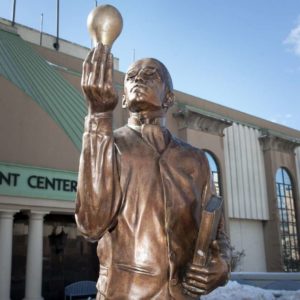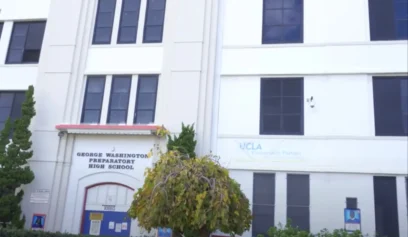
The statue of Lewis H. Latimer was commissioned in 2013 and has stood outside the Margaret E. Morton government center ever since.
A bronze statue depicting prominent African-American inventor Lewis H. Latimer will remain outside the Margaret E. Morton government center in Bridgeport, Conn., after all.
Facing mounting pressure from local Black leaders, Mayor Joe Ganim and his administration on Friday, Feb. 17, reversed their decision to relocate the historic statue to the University of Bridgeport in the South End, where Latimer lived.
“Lewis Latimer is a significant inventor in world history,” Ganim said in a statement. “And he is a proud symbol of everything Bridgeport strives to be: hard working, creative, brilliant and a light unto the world.”
The mayor’s “light unto the world” reference speaks to Latimer’s countless contributions to science and technology, as he worked alongside other notable inventors like Thomas Edison and Alexander Graham Bell. The African-American inventor had deep knowledge of electrical engineering and is credited by some as the actual inventor of the light bulb, as he ultimately patented its design. Additionally, Latimer helped draft the patent for Bell’s telephone design, according to Biography.com.
Ganim said he believes the statue, which shows Latimer holding a light bulb, should remain standing outside the government center, which is named in honor of the first Black member of the Connecticut House of Representatives, the Bridgeport Daily Voice reported.
“Lewis Latimer is one of Bridgeport’s most prominent global citizens and we are extremely proud to honor him in front of our government center,” he said. “It should remain standing proudly in front of the Margaret Morton building as an inspiration to all who see it and as a reminder of everything Bridgeport can be.”
City officials said their initial decision to move Latimer’s statue to the UB campus was driven by former mayor Bill Finch’s decision to pay for the artwork with money that was earmarked for road improvements in the South End. The CT Post reported that Finch spent $66,000 out of a $1 million state grant meant for streetscape improvements.
City Hall suggested that the statue at least be relocated to a community that was a recipient of the grant, noting that the South End was likely a good fit because Latimer had lived there. The university campus was touted as good spot, too, as it was secure and Bridegport leaders felt that the university would take care of the piece.
Besides backlash from Black leaders like Sen. Marilyn Moore and George Mintz, leader of the city’s NAACP, the statue’s sculptor also was put off by the idea of her artwork being moved. New Haven artist Susan Clinard expressed fear that the statue might be damaged during the relocation process.
“The base is one ton and the sculpture itself is probably only about 350 pounds,” Clinard said in an interview last month. “But it’s drilled and anchored in with these pins. It has to be done professionally or it can crack the granite base. … Statues aren’t really supposed to be moved once in.”
Local leaders like Sen. Moore expressed relief at the city’s decision not to remove the iconic statue from the government building, adding that the reversal “makes good sense.”
“And it also should be an indication to the entire community that if we speak up in a united voice, we cannot be silenced,” Moore said. “I am appreciative of the members of the City Council and community who spoke up regarding the statue.”


